Having to fight with the gravitational attraction of two different stars is a challenge for planets orbiting binary stars. Contrary to what happens to circumbinary planets, planetary formation around a single star like our sun is very simple. Astronomers weren’t certain they existed until recently.
Astronomers rarely find binary stars with planets orbiting them. It may be because they’re rare, or it may be because they’re difficult to detect; likely both. Now a team of researchers has found a binary star with more than one planet. This is only the second instance of a multiplanet, binary star system. What does it tell us about these types of solar systems?
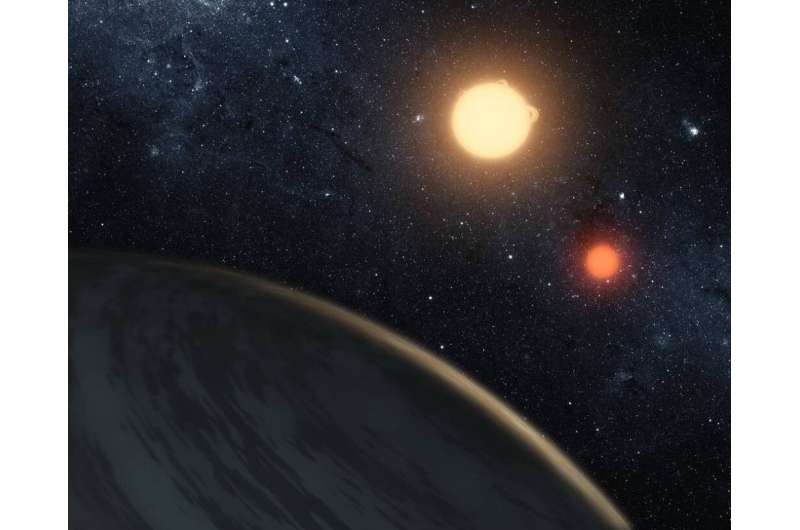
Artist’s impression of Kepler-16b, the first planet known to definitively orbit two stars – what’s called a circumbinary planet. The planet, which can be seen in the foreground, was discovered by NASA’s Kepler mission. Credit: NASA/JPL-Caltech/T. Pyle
The system is called TOI-1338 and is a binary star about 1,300 light-years away in the constellation Pictoris. TOI-1338 a is a main sequence star of 1.12 solar masses, and TOI-1338 b is an M-dwarf (red dwarf) of 0.3 solar masses. The star system is about 4.4 billion years old.
A summer intern at NASA’s Goddard Space Flight Center discovered the first planet around the binary in 2017. TOI-1338 b is a circumbinary planet with about 33 Earth masses and is in between Saturn and Neptune in size. It’s on a 95-day orbit around the binary stars.
Circumbinary planets are hard to find in the data because the stars can eclipse each other, making planetary transits difficult to discern. Their transits can also be irregular, and they can transit in front of only one of the binary stars. TOI-1338 b’s transits occur irregularly, between every 93 and 95 days, making it non-periodic. And since both stars are moving, the depth of the transit varies.
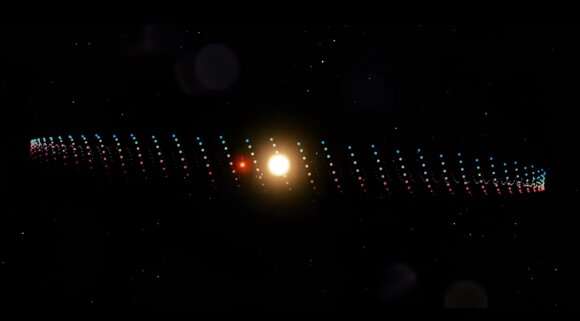
The angle of TOI 1338 b’s orbit around the stars changes over time, so after 2023, there will be an eight-year gap in transits from our point of view. This gap leads astronomers to believe that there are many other circumbinary planets out there, but we have to be observing at the right time to find them. Credit: NASA Goddard Space Flight Center
The angle of TOI 1338 b’s orbit around the stars changes over time, so after 2023, there will be an eight-year gap in transits from our point of view. This gap leads astronomers to believe that there are many other circumbinary planets out there, but we have to be observing at the right time to find them. Credit: NASA Goddard Space Flight Center
Because of TOI-1338 b’s inclination, from our perspective, it will stop transiting in front of its star in November 2023. Then in about 2031, we’ll see the transits again.
Now astronomers have found a second planet orbiting TOI-1338. It’s called TOI-1338/BEBOP-1c, and they found it using the radial velocity method rather than the transit method. The name BEBOP comes from an observing project. “To increase the number of known circumbinary planets and to provide accurate masses for systems discovered with the transit method, we initiated a radial-velocity observing survey dedicated to circumbinary planet detection called Binaries Escorted By Orbiting Planets (BEBOP),” the authors explain in their paper.
The researchers reported their findings in a paper titled “The First Circumbinary Planet Discovered with Radial Velocities.” It has been accepted for publication in Nature Astronomy and is available on the arXiv preprint server. The lead author is Matthew R. Standing, a Ph.D. student at the School of Physics and Astronomy, University of Birmingham, UK.
The new planet is a gas giant of about 65 Earth masses. It’s on a wider orbit than TOI-1338 b and has an orbital period of about 215 days. Astronomers discovered it using radial-velocity data collected with the HARPS and ESPRESSO spectrographs. This discovery marks the first time astronomers have found a circumbinary planet using radial velocity, and the system is only the second multiple-planet circumbinary system found.
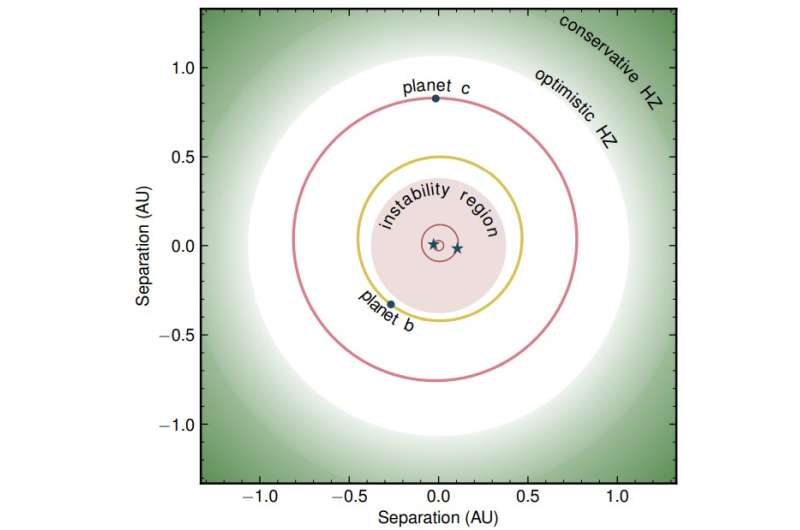
This graphic from the research shows the TOI-1338 system in detail. Planet c has a much wider orbit than planet b, and neither is in the system’s habitable zone. Credit: Standing et al. 2023
This graphic from the research shows the TOI-1338 system in detail. Planet c has a much wider orbit than planet b, and neither is in the system’s habitable zone. Credit: Standing et al. 2023
Astronomers are very interested in circumbinary planets. They’ve been common in science fiction but weren’t confirmed until the Kepler mission found the first one. It is called Kepler-16b, and it’s an oddball in its own way. It is inside the radius that astronomers thought was the inner limit for planets in binary star systems. Kepler-16b has no sibling planets.
Now we know of 12 circumbinary planets, and two of them are in multiplanet systems. The first multiplanet circumbinary system astronomers found is called Kepler-47, and it hosts three known explanets. The BEBOP observing program is designed to uncover more circumbinary planets and discern more about them. Its main goal is to find more of them, and it will accomplish that by overcoming some of Kepler’s observational biases.
Binary star systems are far more complicated than single-star systems like ours. Binary stars disrupt planet formation in ways that more predictable single-star systems don’t. The dual stars create harsh conditions in the protoplanetary environment. Astronomers used to think that planets in these systems would be subjected to catastrophic collisions or be flung out of their systems by gravitational perturbations. But all these recent discoveries show that is not necessarily true. By finding more circumbinary planets and characterizing their similarities with and differences from single-star planets, astronomers will learn a lot about how planets form and migrate.
One of the difficulties in studying circumbinary planets is determining their masses. BEBOP was designed to not only find planets but to measure their masses more accurately. This is critical because knowing their masses helps determine which ones are puffy, with extended atmospheres suitable for atmospheric spectroscopy. BEBOP not only found the second planet, but it measured TOI-1338’s inner planet’s mass more accurately.
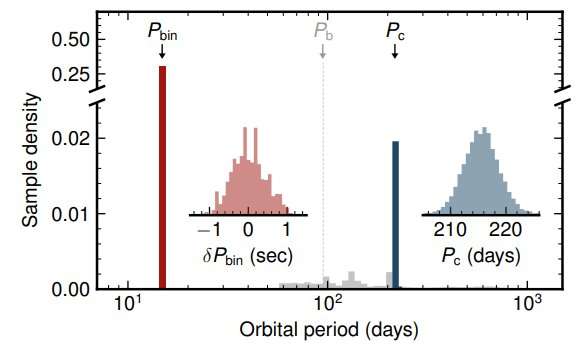
This figure from the study illustrates what the astronomers found in TOI-1338. The red inset graph shows the magnified 14.6-day binary period associated with the stars, and the blue inset graph shows the magnified 215.5-day period of TOI1338/BEBOP-1c. Credit: Standing, et al. 2023
Finding another multi-planet circumbinary system and determining its masses is an important discovery. While these systems upend some parts of the models for how planets form, they’ll ultimately make our models more accurate.
This figure from the study illustrates what the astronomers found in TOI-1338. The red inset graph shows the magnified 14.6-day binary period associated with the stars, and the blue inset graph shows the magnified 215.5-day period of TOI1338/BEBOP-1c. Credit: Standing, et al. 2023
The researchers say that at some point, TOI-1338/BEBOP-1c is guaranteed to transit the primary star, but they can’t say when. That is in spite of the misalignment between the planet and the star. “It may seem counterintuitive at first that a planet-binary misalignment makes transitability more likely,” they write. This is because the planet’s sky inclination oscillates around the binary’s sky inclination, according to the authors, and eventually, the planet’s inclination will approach 90 degrees. That means “… the vast majority of circumbinary planets orbiting eclipsing binaries will eventually transit.”
The team also examined the issue of other planets around the binary star. None have been detected yet, but they may yet be. While they can’t say for sure if there are additional planets, they calculated and graphed the limitations on any potential detections.
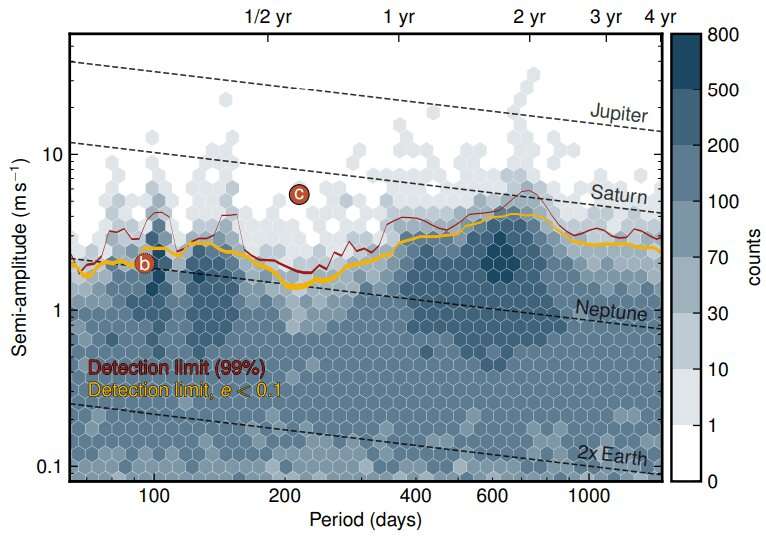
This density plot from the research shows the detection limits of the researchers’ method. It’s pretty complicated, but it basically shows that their method is “…sensitive to additional sub-Saturn mass planets for periods out to 2000 days, while we are sensitive to Neptune mass planets near the instability limit.” Credit: Standing, et al. 2023
This density plot from the research shows the detection limits of the researchers’ method. It’s pretty complicated, but it basically shows that their method is “…sensitive to additional sub-Saturn mass planets for periods out to 2000 days, while we are sensitive to Neptune mass planets near the instability limit.” Credit: Standing, et al. 2023
One of the problems with studying circumbinary planets around binary stars is that most of the ones of which we are aware are too faint. That means that for most of them, including the new planet TOI-1338/BEBOP-1c, there’s no opportunity to employ spectroscopy to probe their atmospheres. But its previously discovered sibling, TOI-1338b, might be illuminated enough. “Therefore,” the researchers write, “despite the challenges it may present, TOI-1338/BEBOP-1b is our only possibility to shed light on the atmospheric make-up of circumbinary planets.”
“Of the now 15 known circumbinary exoplanets, TOI-1338/BEBOP-1b is the only one for which James Webb Space Telescope transmission spectroscopy can currently be pursued. If we are to unveil the mysteries of circumbinary Tatooine-like exo-atmospheres, the TOI-1338/BEBOP-1 system provides a new hope,” the authors write in their paper.
Source: phys.org








